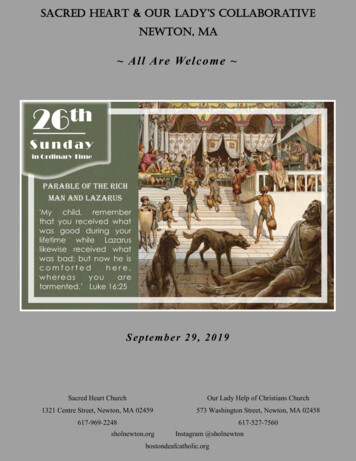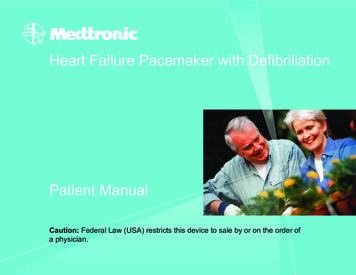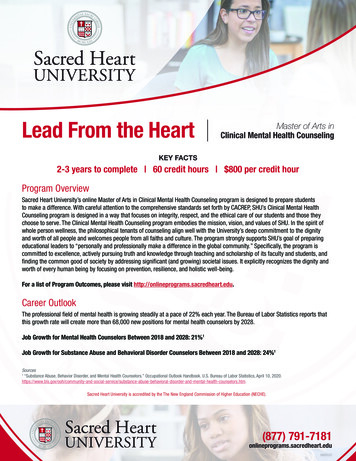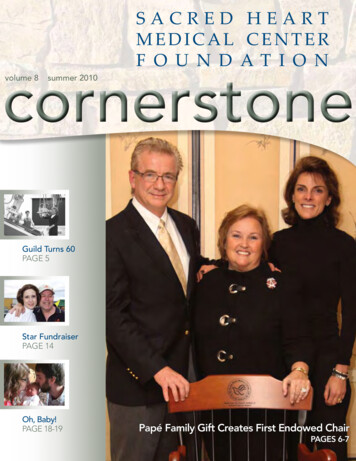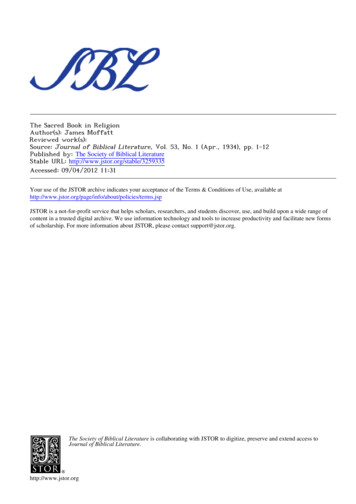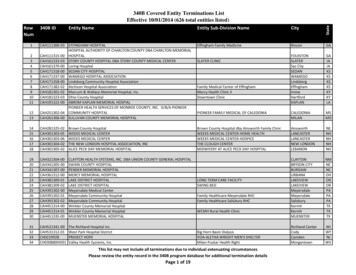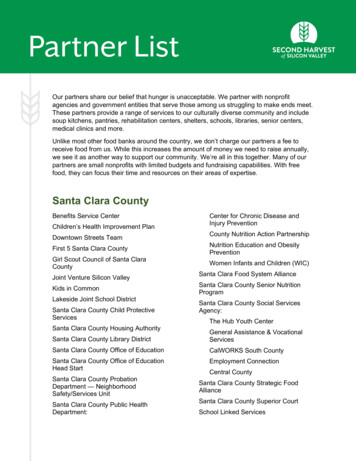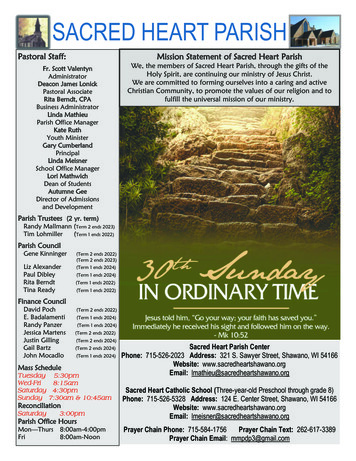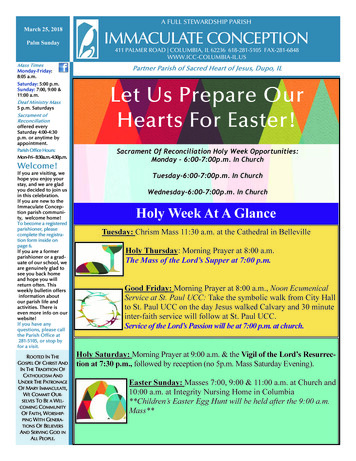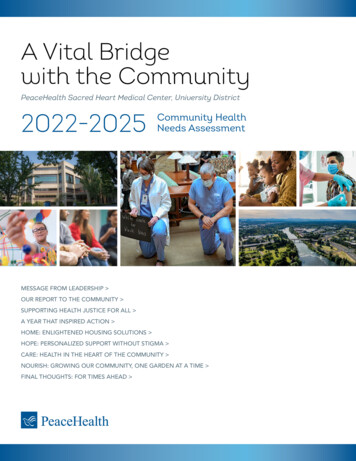
Transcription
A Vital Bridgewith the CommunityPeaceHealth Sacred Heart Medical Center, University District2022-2025Community HealthNeeds AssessmentMESSAGE FROM LEADERSHIP OUR REPORT TO THE COMMUNITY SUPPORTING HEALTH JUSTICE FOR ALL A YEAR THAT INSPIRED ACTION HOME: ENLIGHTENED HOUSING SOLUTIONS HOPE: PERSONALIZED SUPPORT WITHOUT STIGMA CARE: HEALTH IN THE HEART OF THE COMMUNITY NOURISH: GROWING OUR COMMUNITY, ONE GARDEN AT A TIME FINAL THOUGHTS: FOR TIMES AHEAD
PeaceHealth Sacred Heart Medical Center, University District2022 Community Health Needs AssessmentMessage from leadership:Our downtown Eugene community has grown vastly over the years. It is now a landscape of change, with anabundance of new eateries, hotels and sports complexes positioned between community dining halls, temporaryhousing and within blocks of tent-filled parks.Amidst these changes and differences, our community comes together and unites to help those in need and toadvocate for justice. Our focus is on the most vulnerable and at risk in our community; low-income families, seniors,the unhoused and at-risk youth; Black, Indigenous and People of Color; Lesbian, Gay, Bisexual, Transgender, Queerand Intersex; and those needing support with mental health and substance abuse.Social distancing diminished the limited safe shelter space available in the area and put additional stress on the dailylives of the unhoused in our community. The Lane County Poverty and Homelessness Board—with its many housingfocused community agencies—placed collective energy into creating safe sleeping space and alternate distancedsheltering when we needed it most.When wildfires forced hundreds out of their rural homes and into the City of Eugene seeking housing, our lodgingindustry opened its doors while our community partners organized. They provided food, clothing, emergency suppliesand other family supports: Wi-Fi for distance learning, accommodations for family pets, access to grief counselingand more. They are too numerous to name, but each of these organizations deserves hero recognition for theirmonumental efforts.We are a community of activists, with more than 7,000 people amassing in the summer of 2020 in solidarity to protestracial injustice. This year challenged us to rethink how we collaborate as a community, to bring more dignity, respectand humility to our work. We are humbled by our community’s response and, realize through all of this, there is evenmore work to be done.It is a process, a learning experience and an evolutionary journey that we are ready for. PeaceHealth is committedto confronting racism in healthcare and will advocate for social and health justice to fulfill our PeaceHealth Missionof treating each person in a loving and caring way. We are honored to be a part of this work and stand beside ourpartners, those we serve and our community.With gratitude,Alicia BeymerSusan BlaneChief Administrative OfficerDirector of Community HealthBACK TO TABLE OF CONTENTS1 of 21NEXT: OUR REPORT TO THE COMMUNITY
PeaceHealth Sacred Heart Medical Center, University District2022 Community Health Needs AssessmentOur report to the communityThe importance of a Community Health Needs AssessmentEvery three years, each PeaceHealth location conducts a Community HealthNeeds Assessment (CHNA) as required by the 2010 Patient Care andAffordable Care Act.Tax-exempt hospitals like ours—as defined by IRS Section 501(r)—use theCHNA to report current community needs, statistics and activities. We arealso expected to develop an implementation strategy outlining our plans toimprove the health and well-being of the communities we serve.We see our CHNA report and implementation strategy as much more than a requirement or obligation. Through thisnarrative, we are presenting the story of our dedication and service to the community and people we serve. Beyondtraditional medical services and care, we are committed to helping people in need.Click to view previous editions of our CHNA and implementation strategyWHAT IS OUR COMMUNITY NEEDS ASSESSMENT PROCESS?The Live Healthy Lane Community Health Improvement Plan partners—PeaceHealth Oregon, Lane County PublicHealth, Lane Community Health Council, Trillium Community Health Plan and United Way—conducted extensivecommunity-wide needs assessments from January through July 2020, engaging community stakeholders from multiplesectors and referencing recent community studies and reports.OUR KEY FINDINGSSocial justice consistently rose to the top of our community’s stated priorities. We identified a critical call for improvedhealth equity for Black, Indigenous and People of Color; Lesbian, Gay, Bisexual, Transgender, Queer and Intersex;those living in rural and remote areas; and other vulnerable and at-risk members of our community. Live Healthy Lanedata indicated inequities led to higher risk behaviors such as tobacco and binge drinking, and reduced access andutilization of healthcare services. These, in turn, result in higher rates of disease and increased mortality.Investments in housing availability and affordability for families is a key theme, as is the need for support servicesincluding childcare and access to healthy food and healthcare. Investing in more community health workers, PeerSupport Specialists, navigators and other traditional health worker roles—and locating them in schools for families,children and adolescents—is also a priority in our community.The assessment further identified the need for access to mental healthcare and substance abuse prevention,noting a concerning trend of worsening mental health among Lane County residents, especially youth.We hear these needs, and we are committed to leveraging our resources, funding, voices and partnership toaddress disparities and gaps to provide whole-person care in Lane County.2 of 21
PeaceHealth Sacred Heart Medical Center, University District2022 Community Health Needs AssessmentWHO WE ARE AND WHAT WE BELIEVE INEugene, Oregon is a vibrant social center known for education and innovation.Located in the heart of the “Emerald City,” PeaceHealth Sacred HeartMedical Center, University District continues that tradition as a source ofhealth education and support for our rapidly growing and increasingly diversesurrounding community.About PeaceHealth SacredHeart Medical Center,University DistrictThat is why it is critical that PeaceHealth—as the region’s major hospitalsystem, together with our medical groups and network of primary andspecialty clinics—provides equal access to high-quality, appropriate andintegrated community care. We work closely with Federally Qualified HealthCenters such as Community Health Centers of Lane County and White Bird,safety net and free clinics like Volunteers in Medicine, and community-basedservice organizations.Combined average daily census ofInpatient Medical, Behavioral Healthand Rehab Units6310.85Average daily censusPeaceHealth Sacred Heart Medical Center, University District serves thecommunity with nonsurgical inpatient hospital care, inpatient rehabilitation,much-needed behavioral health services and a highly utilized level 3emergency department. Outpatient services focus on innovative behavioralhealth programs and youth services, and the emergency department alignswith community services like Crisis Assistance Helping Out On The Streets(CAHOOTS) and ShelterCare to maximize support to unhoused patients.117The hospital works closely with youth programs like 15th Night and LookingGlass to ensure at-risk youth arriving at our doors receive coordinated,compassionate, whole-person care—as well as access to support serviceswhen leaving the hospital.879The University District hospital is the original PeaceHealth campus in Oregonand has served the community since 1936 when the Sisters of St. Josephwere invited to Eugene to help the struggling hospital. Now, PeaceHealthis embarking on the biggest change to the campus since the hospital wasexpanded in the 1980s. The oldest of the original buildings is being torn downto create open greenspace, while several public areas in the hospital are beingmodernized to create warmer, welcoming spaces for hospital visitors.Total licensed beds4.51Average length of stay (days)Inpatient discharges16,347Outpatient clinic visits1,217Employees845Active medical staff27,849Emergency Department visitsSource: PeaceHealth FY 2021;Active medical staff as of October 2021BACK TO TABLE OF CONTENTS3 of 21NEXT: SUPPORTING HEALTH JUSTICE FOR ALL
PeaceHealth Sacred Heart Medical Center, University District2022 Community Health Needs AssessmentSupporting health justice for allFrom our very beginning to the present dayPeaceHealth was founded by the Sisters of St. Joseph of Peace, who traveledwest in 1890 to care for early settlers and people in need. Their legacycontinues today as we recognize that achieving health and well-being is alifelong journey.We are committed to our Mission: We carry on the healing Mission of JesusChrist by promoting personal and community health, relieving pain andsuffering, and treating each person in a loving and caring way. We are drivenby our belief that good health, prevention and community well-being arefundamental rights. We support health justice for all and are especially calledto be in service to the most vulnerable members of our community. And webelieve that every person should receive safe and compassionate care—everytime, every touch.BUILDING A NETWORK OF CARE FROM THE INSIDE OUTInspired by a challenge from the Catholic Health Association’s “We AreCalled” Pledge, we have embarked on a journey to “put our own housein order.” We recognize that change starts from within, believing that ouremployees can best focus on others when we put our focus on caring forthem. This has been an essential element in preserving our 130-year legacyof community service and care.With more than 5,400 employeesin Lane County—1,217 of thosethroughout the Sacred HeartMedical Center, University Districtservice area—PeaceHealth is oneof the largest employers in LaneCounty. Our employees are avital part of our community. Likeeveryone else, they have beendeeply impacted by the pandemic.With this, we recognize the weightand responsibility of caring for bothour community and our employees.Over the last two years, 637employees in the Lane County areahave received support with housingand utilities (51%), access to careor basic services like internet andtransportation (31%) and food4 of 21“ We have a responsibilityto shine a light on theprofound effect inequitieshave on health andwell-being, and to dosomething about it. Weare called to promote theinherent dignity of eachperson, to further thecommon good and seekjustice through solidarity,especially in service to themost vulnerable.”– Liz Dunne, President and Chief ExecutiveOfficer, PeaceHealth
PeaceHealth Sacred Heart Medical Center, University District2022 Community Health Needs Assessmentaccess (18%). This is just the beginning. In addition to providing care and resources, PeaceHealth continues to refineour hiring practices to encourage the growth of a diverse workforce. We are committed to implementing changereflective of our Core Values: respect, stewardship, collaboration and social justice.But we need to do more—and we cannot do it alone. This is why community-based partnerships like the onesdescribed in this CHNA report are crucial to our community’s success. They enable all of us to address socialdeterminants of health and improve care and access—regardless of where individuals are in their health journey.STRIDES FOR SOCIAL JUSTICEStrides for Social Justice launched in February 2021 at a pivotal time in ourcities, state and country. The urgency for crucial conversations around socialjustice and the need for understanding the history of racism in Lane Countycrossed all sectors of our community.Before the pandemic closed many social and community events, PeaceHealthpartnered with the Eugene Marathon to create an inclusive, family-friendlyprogram to engage and educate participants on the contributions andchallenges of Black residents in our community while generating financialresources to support organizations focused on social justice initiatives.MOVING PEOPLE PHYSICALLY, MENTALLY AND EMOTIONALLYThe free Strides for Social Justice app guides participants to variouslandmarks, mapping a journey through local Black history. The app engagesparticipants at each landmark, demonstrating the historical milestones,contributions and achievements of Black residents while also promotinghealth and wellness.Our hope is to influence our community, effect changes that enhance physicaland mental health, and contribute to a socially just and unified Eugene/Springfield by: Fostering a greater appreciation and understanding of how Black history,Black residents and the Black experience have shaped our community. Engaging community members in healthy physical activities like walking,running or riding between landmarks. Connecting with community members in practices of reflection andinspiring movements of the heart. Encouraging patronage of local Black-owned businesses. Generating funds toward programs providing opportunities for theNAACP’s Mattie Reynolds Scholarship, Oregon Black EducationFoundation and other similar organizations.5 of 21
PeaceHealth Sacred Heart Medical Center, University District2022 Community Health Needs AssessmentPROMOTING SOCIAL JUSTICE ACROSS LANE COUNTY—AND BEYONDPeaceHealth has taken steps to increase awareness of social inequities and promote health justice among patients,employees in our organizations and across the greater healthcare community. We also recognize the significant journeythat lies ahead—with partners and with our community—to move the needle on health justice, equity and inclusion.The people of Lane County still identify as predominantly white, but that is changing as our community grows.According to the U.S. census, Lane County‘s population increased by more than 10% from 2010 to 2020 while alsobecoming more diverse. This trend toward greater diversity has accelerated in the last three years, bringing with it theneed for more awareness, inclusive education and different ways to bring healthcare and social services to the peoplemost in need.RECOGNIZING INEQUITIESAND ELEVATINGPARTNERSHIPSDuring these unprecedented times,it has become evident that Black,Indigenous and People of Colorcommunities are at higher risk forchronic medical conditions. With lessaccess to healthcare, immigrationconcerns, language barriers, higherpoverty rates and the likelihood ofworking in close contact with otherpeople in essential worker jobs,these members of our communityare at a higher risk of severeoutcomes from COVID-19.In response, PeaceHealth haspartnered with White Bird FederallyQualified Health Center, HIVAlliance, Volunteers in Medicine,NAACP of Eugene/Springfield andCatholic Community Services of LaneCounty. These organizations aretrusted service providers supportingthe needs of Black, Indigenousand People of Color populations,as well as Lesbian, Gay, Bisexual,Transgender, Queer and Intersexcommunities.Community benefit funds totaling 35,000 were awarded to theseorganizations to support popup COVID vaccine clinics in theA growing community EUGENE:LANE ion2010-20 population growth2010-20 population growthSource: World Population Review is becoming an increasingly diverse one% Race/Ethnicity Data of PopulationEugeneLane can Indian/Alaska Native 1221Native Hawaiian/Pacific Islander 1 1 1 1Source: U.S. Census6 of 21
PeaceHealth Sacred Heart Medical Center, University District2022 Community Health Needs Assessmentcommunity with special outreach to vulnerable populations. This is in additionto 10,000 in community benefit funding to Lane County Public Health for theadvancement of COVID vaccination education.The Community Vaccination Collaborative organized by the Lane CommunityHealth Council has closely tracked where disparities in vaccination rates in ourcommunity exist and pursued innovative methods for bringing the vaccinationclinics to those who needed it most.Source: U.S. CensusBACK TO TABLE OF CONTENTS7 of 21NEXT: A YEAR THAT INSPIRED ACTION
PeaceHealth Sacred Heart Medical Center, University District2022 Community Health Needs AssessmentA year that inspired actionAnswering the call of an unprecedented time in history2020 saw a remarkable convergence of critical challenges in the UnitedStates: racial and social justice and COVID-19. The pandemic has cast abrighter light on how continuing inequities in income, education and accessto health and social services inordinately affect Black, Indigenous andPeople of Color segments. As the pandemic has progressed, it has becomeclear that vulnerable members of our community were more at risk forinfection, hospitalization and death. In response, we increased our inpatientrehabilitation beds at Sacred Heart Medical Center, University District by 33%and added 20 staff members to support more inpatient behavioral healthpatients.We also took a closer look at data from Lane County and our PeaceHealthfacilities. For example, 26.5% of patients admitted for COVID-19 identifiedas Latinx, yet they comprise 8% of the overall local population. This datasuggests that—like other healthcare systems across the country—our facilitiesare seeing at least double the rate of hospitalization in the Latinx communityas compared to the white population.By the end of October 2021, 75.3% of Lane County residents had receivedat least one dose of any COVID-19 vaccine (Moderna, Pfizer or Johnson &Johnson). Yet disparities exist. With vaccination rates for Black, Indigenousand People of Color segments hovering near 50%, the pandemic highlights anongoing need for change, community connectedness and creative solutionsfor education and care.In addition to pandemic-related challenges, another factor looms large infurther hindering access to care and health outcomes for these segments. Thepopulation of Eugene and Lane County is rapidly growing; with this growthcomes the need for more care, particularly in the areas of general practice,dentistry and mental health. Yet the number of available providers for basicand critical care services is declining. This has created a significant gap inavailable healthcare services, driving up wait times and wait lists, and makingit nearly impossible to access care in more rural communities.Exacerbated by the grueling realities of the pandemic, there is an urgentneed to address the workforce shortfall, improve the provider pipeline andestablish quality community care options.In order to meet growing care needs, it has never been more important forus to promote collaboration with our community partners while expandingcommunity-based clinics, referral and care options, and alternative carepractices.8 of 21COVID-19’sDisproportionate Impact8%of total patients identifyingas Hispanic/Latinx26.5%of patients testing positive forCOVID-19 from Hispanic/LatinxpopulationSource: PeaceHealthPercent of fully vaccinated,by race and ethnicity60.8%of Lane County is fully vaccinated,and of thoseAsianWhiteNative 90%Hawaiian/PacificIslander68%67%Black/African 54%AmericanHispanic/LatinX50%American Indian/ 49%Alaska NativeSource: Oregon Health Authority, as of 10/29/2021
PeaceHealth Sacred Heart Medical Center, University District2022 Community Health Needs Assessment“ As our population ages,CARING FOR ESSENTIAL WORKERS AND THEIR CHILDRENWhen schools shut down in 2020, frontline healthcare and essential workerswere in desperate need of childcare. Eugene Family YMCA partnered withemergency services and local school districts to set up emergency childcare,allowing these vital workers and community heroes to go to work knowingthat their families were safe. PeaceHealth was able to partner with the YMCAto provide 50,000 in funding for childcare operations and infrastructuresupport.United Way, KinderCare and First Baptist Church collaborated to supportthe next phase with subsidized pop-up childcare and distance learningresources for families, providing easy access to supervised online education incoordination with school districts.Since then, the community conversation has turned to a longstanding butnewly highlighted need in our community: reliable licensed childcare servicesfor all families regardless of financial status.PROVIDING CRITICAL SUPPORT IN CHILDCAREFor families experiencing poverty, 2020-21 was particularly harrowing. Manylost their source of income during pandemic shutdowns, putting them behindon rent and living expenses. On top of struggling to keep their familiessafe and fed, parents suddenly found themselves juggling multiple roles ascaregivers, teachers and working parents. The struggle to maintain self-careamid so many challenges and unknowns sent growing numbers of youth,parents and families into emotional and physical distress.During school closures, 60% of families experienced a disruption in theirchildcare (and the percentage was even higher for families of color). Thisput additional strain on already limited options for families needing nontraditional hours or drop-in care for changing circumstances—and even feweroptions for those with young infants or special needs children.9 of 21there is a greater need forhealthcare. But many ofour current providers ofthe same age group areretiring, so we need toattract new generationsof providers. In order todo so, we must addressworkforce disconnectionsaround skills, benefits,consideration for healthand childcare becausethey are dangeroussources of stress for ourcommunities.”– Meghan McCarthy, System Director ofCommunity Health, PeaceHealthKEY BENEFITS Supported 260 workerscontributing to the localeconomy in a time of crisis. Built a foundation forschool-aged childcare solutionsduring pandemic closures. Provided subsidized childcareoptions and virtual educationoptions for the community.
PeaceHealth Sacred Heart Medical Center, University District2022 Community Health Needs AssessmentThe cost of care also has increasedsignificantly over the last 20 years.Federal poverty guidelines have notchanged, however, leaving manylow-income working families unableto access enough public funding toafford adequate childcare.In addition, the childcare workforcehas diminished by 37% and issignificantly undercompensated forthe skillset and training required. All36 Oregon counties are classifiedas childcare “deserts” for infantsand toddlers, meaning that thereare at least three children underthe age of 2 for every availablechildcare slot. With strict licensurestandards in place and few trainingand certification programs available,the childcare workforce will continueto decrease without support for anddevelopment of appropriate trainingprograms.PeaceHealth hears this need in thecommunity and is committed toexploring and supporting partneredchildcare solutions that will createquality, affordable and accessiblechildcare in all Lane Countycommunities.Many parents with young childrenface a painful choice betweenspending a significant portionof their income on childcare,settling for cheaper but potentiallylower-quality options or leavingthe workforce entirely. Thischildcare crisis in our communitydisproportionately impacts women,often forcing them to leave theirjobs to care for children.This exodus of women from theworkforce is a concern for theentire community. Not only doesChildcare realities during the pandemic60%-16%Source: Oregon Department of EducationSource: Oregon Department of EducationAll 36 ORcountiesup to 98%families experiencing childcaredisruption during pandemicqualify as childcare deserts forinfants and toddlersdecrease in Lane County childcarefacilities, March 2020-August 2021of all occupations pay more thanearly childhood education jobsSource: Center for the Study of Child CareEmploymentSource: Oregon State UniversityChildren whose care was disrupted by COVID-19All children59.5%Children at or below 200% of Federal Poverty Level52%Children experiencing disabilities and/or chronic medical needs63.5%American Indian & Alaska Native children57.1%African American & Black children73.8%Asian children67.5%Hispanic & Latinx children50.3%Middle Eastern & North African children57.1%Native Hawaiian & Pacific Islander children54.5%White children61.9%Multiracial/Multiethnic children61.9%Source: Oregon Department of Education, Early Learning Division1 in 4women who reportedbecoming unemployedduring pandemic dueto lack of childcareSource: Americanprogress.org10 of 2160%15 million 60%single U.S. mothers mostseverely affected byschool closuresSource: National Bureau ofEconomic Researchchildcare provided bywomen in two-parenthouseholds whereboth work fulltimeSource: National Bureau ofEconomic Research
PeaceHealth Sacred Heart Medical Center, University District2022 Community Health Needs Assessmentit accelerate the workforce shortage, it also destabilizes family income. Thisputs families at risk for food and housing insecurity, mental health issues andother key community health risk factors. Childcare is a community concernand must be addressed to support a thriving and well-balanced futureeconomy in our region.HO MEOUR FOUR PILLARS OF COMMUNITY HEALTHWe are determined to help create a healthy community beyond the walls ofour medical centers and clinics. That purpose is informed by our four pillarsof community health. Across these pillars is the awareness of our solemnresponsibility to protect the most vulnerable and underserved people in ourcommunities while promoting diversity, equity and inclusion in everythingwe do. These four pillars include: HOME: Improve access to service-enrichedhousing; HOPE: Increase education, access to treatment and preventionof dependence; CARE: Expand knowledge, access and engagement withcommunity caregivers; and NOURISH: Address food insecurities to enhancefamily and child well-being.Improve access toservice-enriched housingHO PEIncrease education, access totreatment and preventionof dependenceSHINING A LIGHT ON EQUITYOur priority is to provide the overall best care possible to our entirecommunity. To do this, we need to provide an equitable system of supportthat recognizes needs, focuses on overcoming barriers and builds resiliencyfor key segments in our community, including:YouthSeniorsBlack,Indigenousand Peopleof ColorPeople whoidentify as Lesbian,Bisexual,Gay, Queer,Transgender,and IntersexC A REExpand knowledge, accessand engagement with communitycaregiversN O U RI S r are at risk ofhomelessnessBACK TO TABLE OF CONTENTSPeoplewithdisabilitiesPeople livingin rural areas11 of 21Address food insecurities toenhance family and child well-beingNEXT: HOME: ENLIGHTENED HOUSING SOLUTIONS
PeaceHealth Sacred Heart Medical Center, University District2022 Community Health Needs AssessmentHOMEEnlightened housing solutionsRestorative, housing-first models for individuals experiencing chronic homelessnessLane County has few housing options for the large number of residents whocannot afford to purchase a home. As of 2019, 58% of the population rentedversus owned and, by 2021, the county’s vacancy rate had plunged to littlemore than 2%. During the pandemic, an eviction moratorium has helped keepsome families and individuals out of homelessness, but this safety net willsoon be ending. Our community will most likely see rent increases—and anew wave of homelessness and unsheltered living.PeaceHealth directly invests in developing housing focused on preventingfuture homelessness. To accomplish that goal, these housing investments mustbe affordable and include integrated social services. To that end, PeaceHealthis partnering with agencies and nonprofit organizations to holistically addresscommunity wellness through supportive and stable housing.While our community response to building more service-rich housing optionshas been growing, it is not enough to match the disparity between availabilityand lack of income. We must do more.THE COMMUNITY SPOKE—AND WE LISTENEDWe are working with our partners to target efforts that supporthomeless prevention services and upstream approaches for wholeperson care.Heading into 2020, the number of people experiencing homelessness hadbeen steadily rising in Lane County, including the Eugene area. Driven by theCOVID-19 pandemic and physical distancing guidelines, traditional shelterswere forced to limit capacity, further putting pressure on an already vulnerablecommunity.Research shows that people experiencing chronic homelessness consume morethan half the available shelter space, utilize a higher percentage of hospitalemergency services, require longer care, and have higher rates of incarcerationand repeat offenses.As a result, PeaceHealth partnered with Homes for Good, Lane County andothers to launch The Commons on MLK housing, which opened in early 2021.The facility focuses on those who experience homelessness the longest, whoaccess the most resources and who have traditionally been the hardest to12 of 21Housing realities ofLane County58%of Lane County resident rents2.01%vacancy rateSource: Department of Numbers
PeaceHealth Sacred Heart Medical Center, University District2022 Community Health Needs Assessmentserve. These individuals often struggle with complex, overlapping physical andmental health issues as well as substance abuse disorders. Directly targets chronichomelessness.PROVIDING PERMANENT HOUSING TO PEOPLEEXPERIENCING HOMELESSNESSThe Commons on MLK follows the model of Housing First to provide a safeand stable home foundation so that residents can focus on improving theirhealth and quality of life. This approach features 24/7 wraparound servicesand supportive programs that are more effective than shelters and transitio
Eugene, Oregon is a vibrant social center known for education and innovation. Located in the heart of the "Emerald City," PeaceHealth Sacred Heart Medical Center, University District continues that tradition as a source of health education and support for our rapidly growing and increasingly diverse surrounding community.

